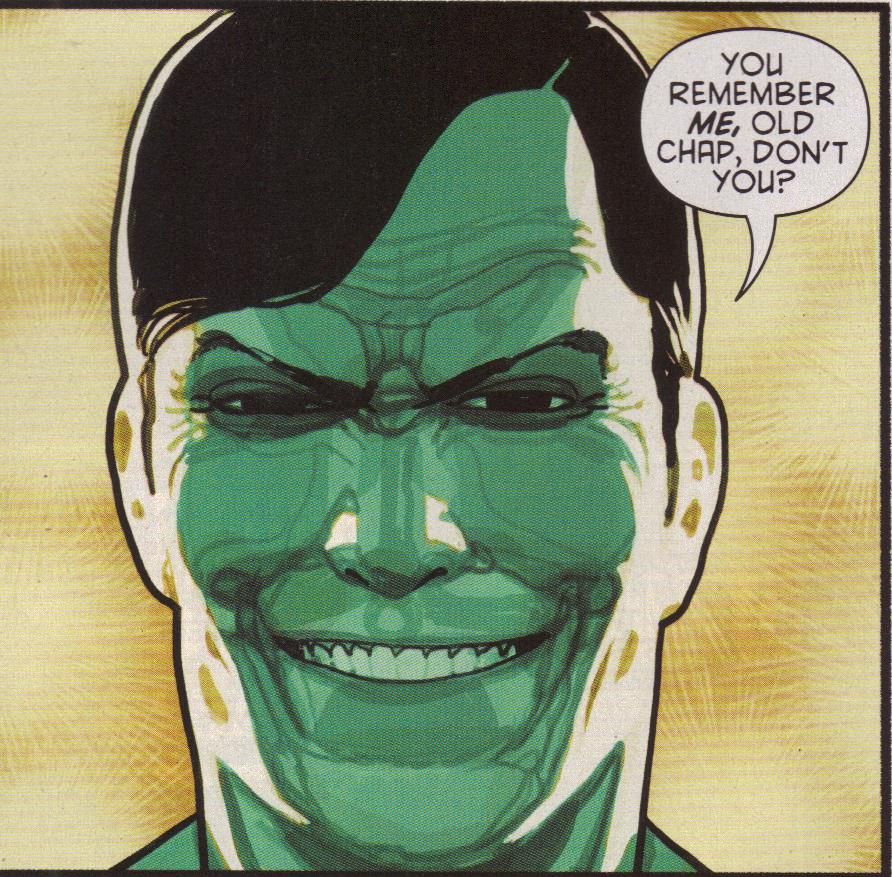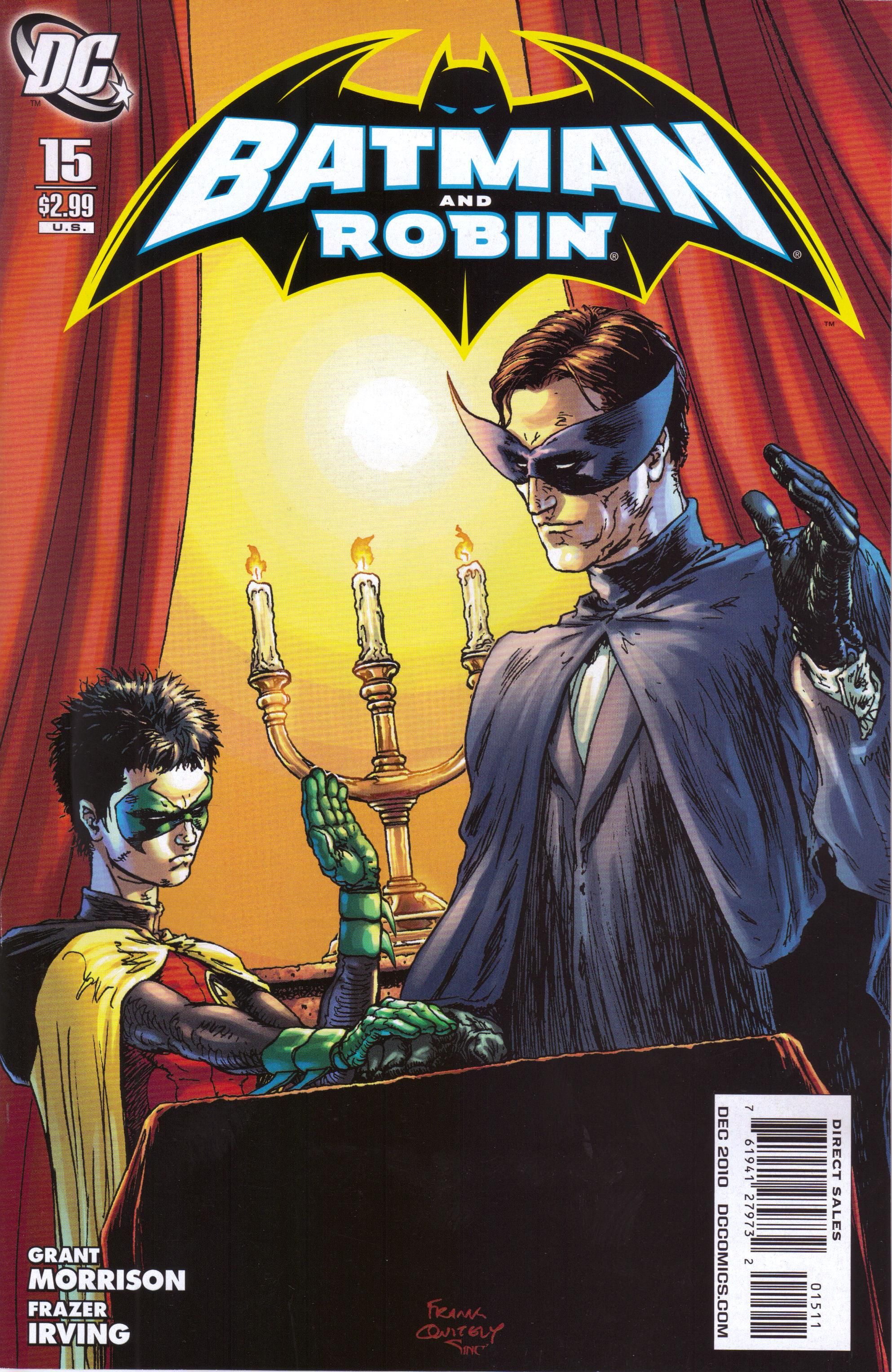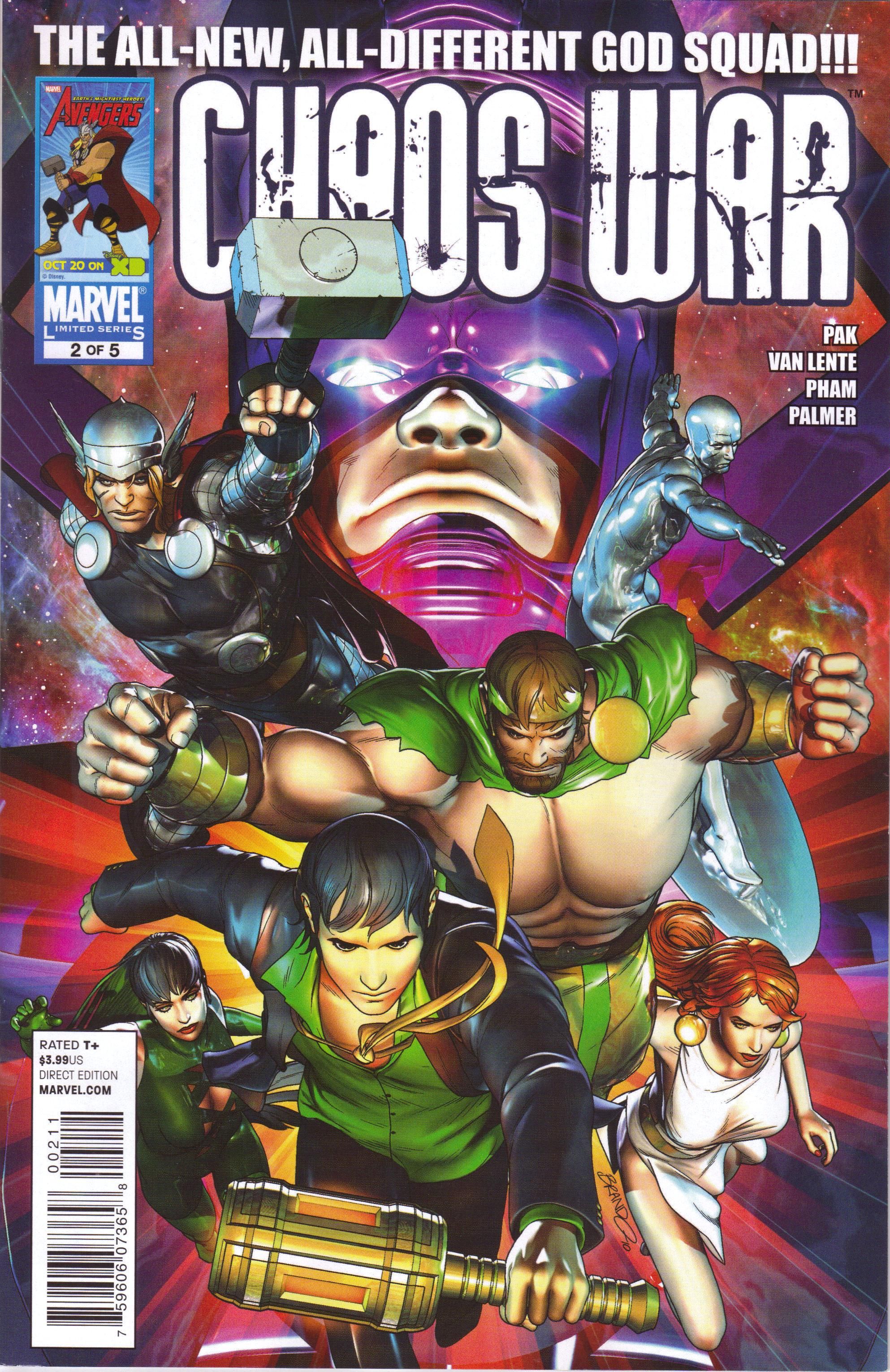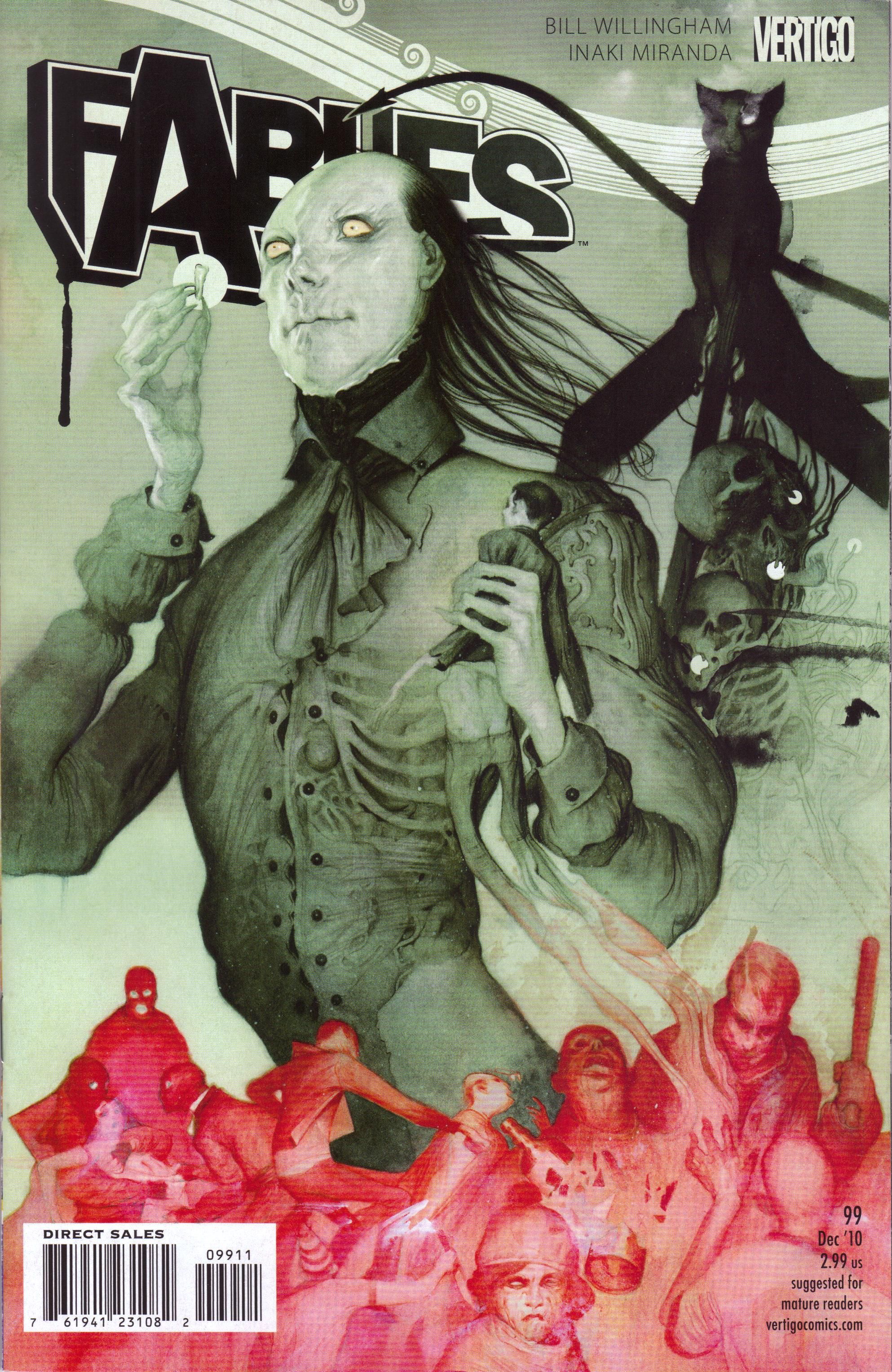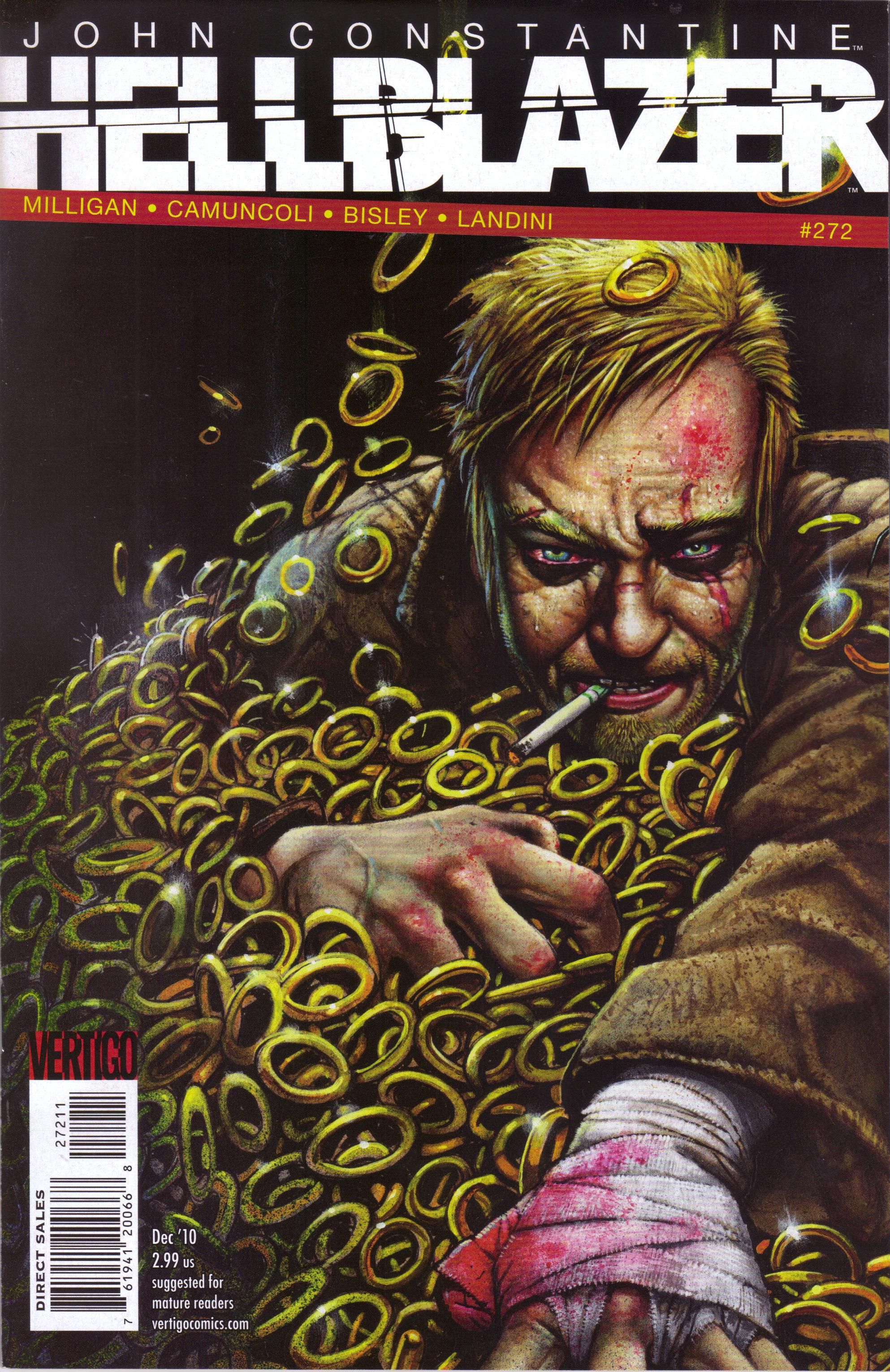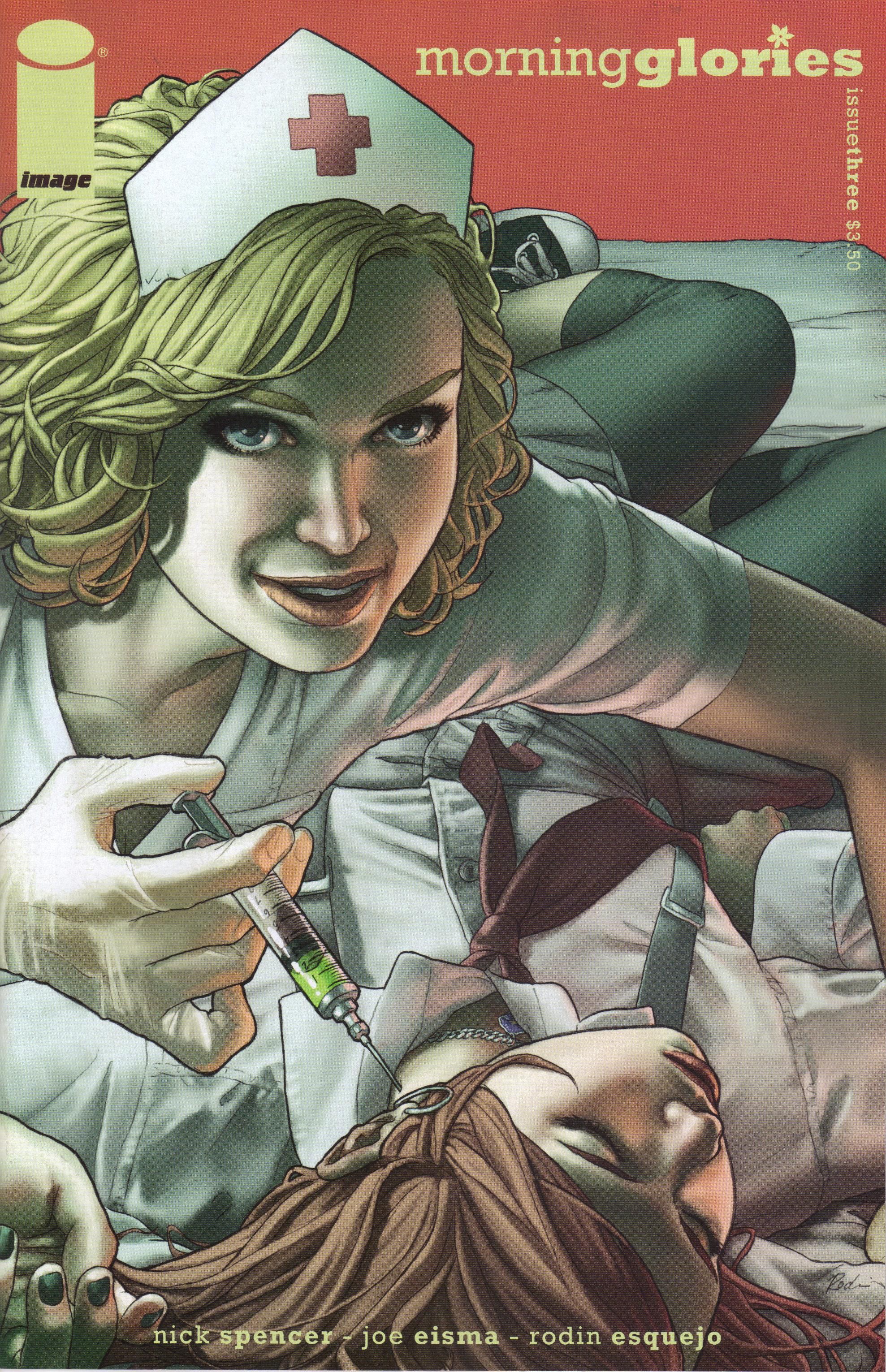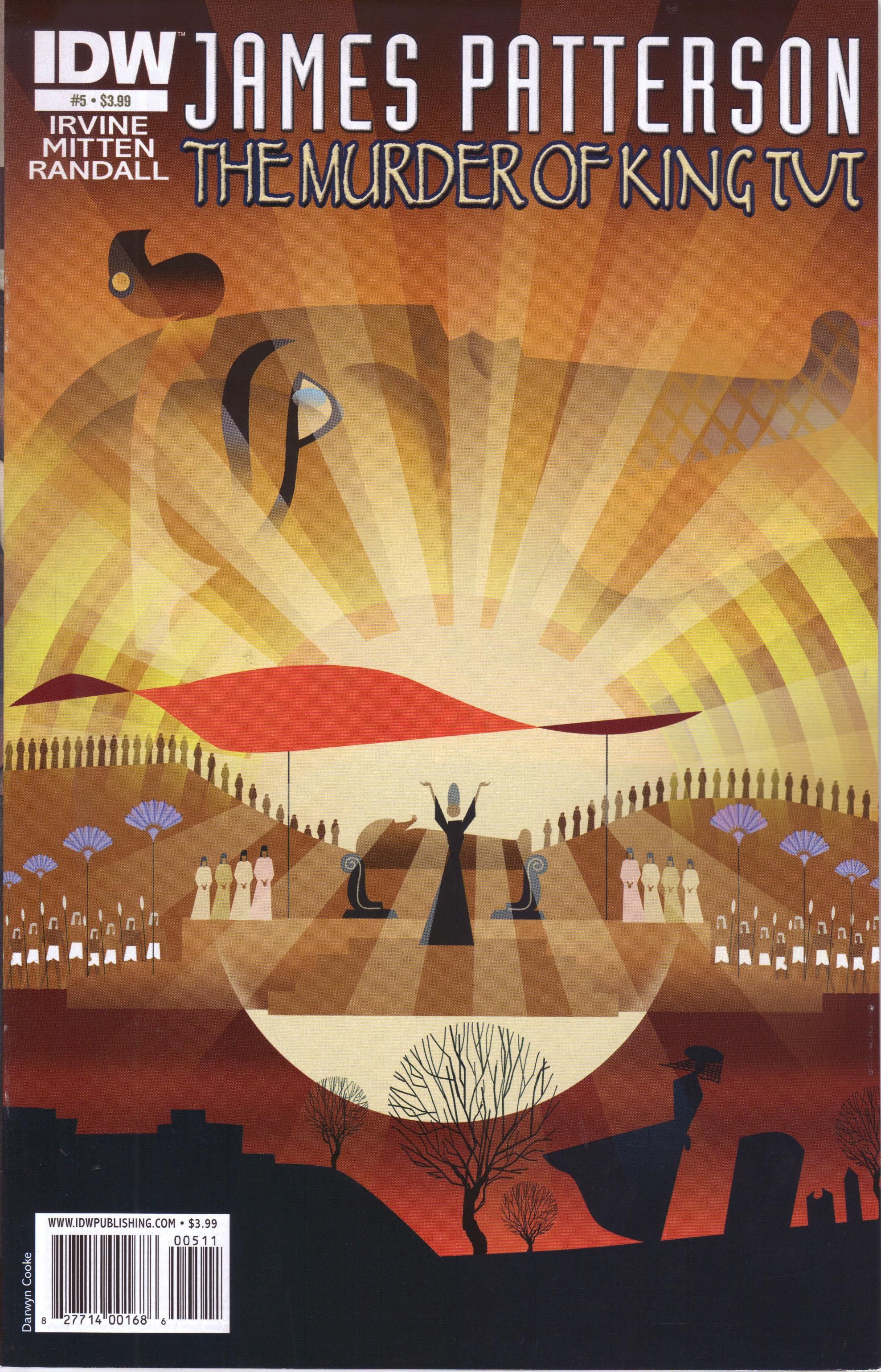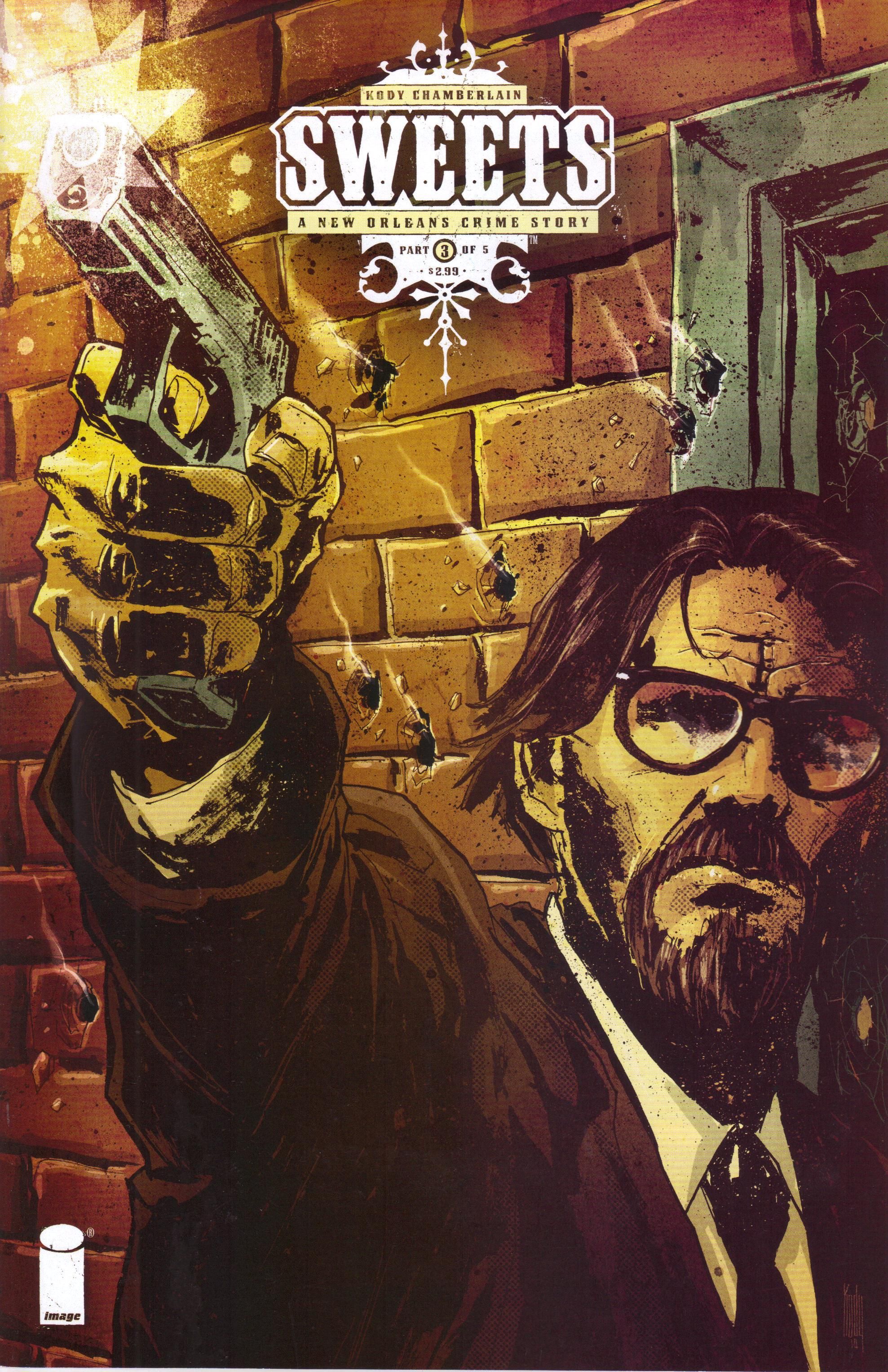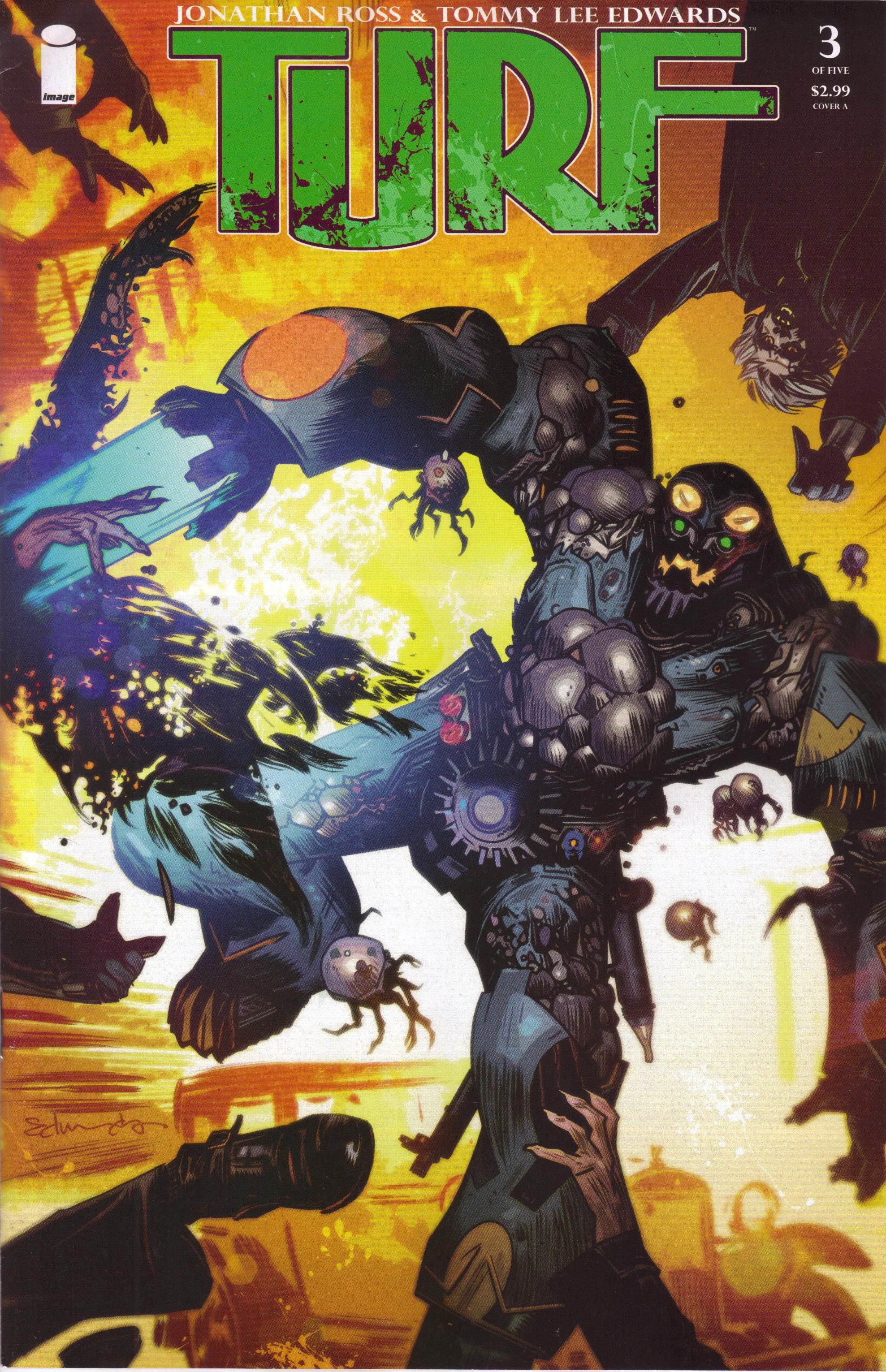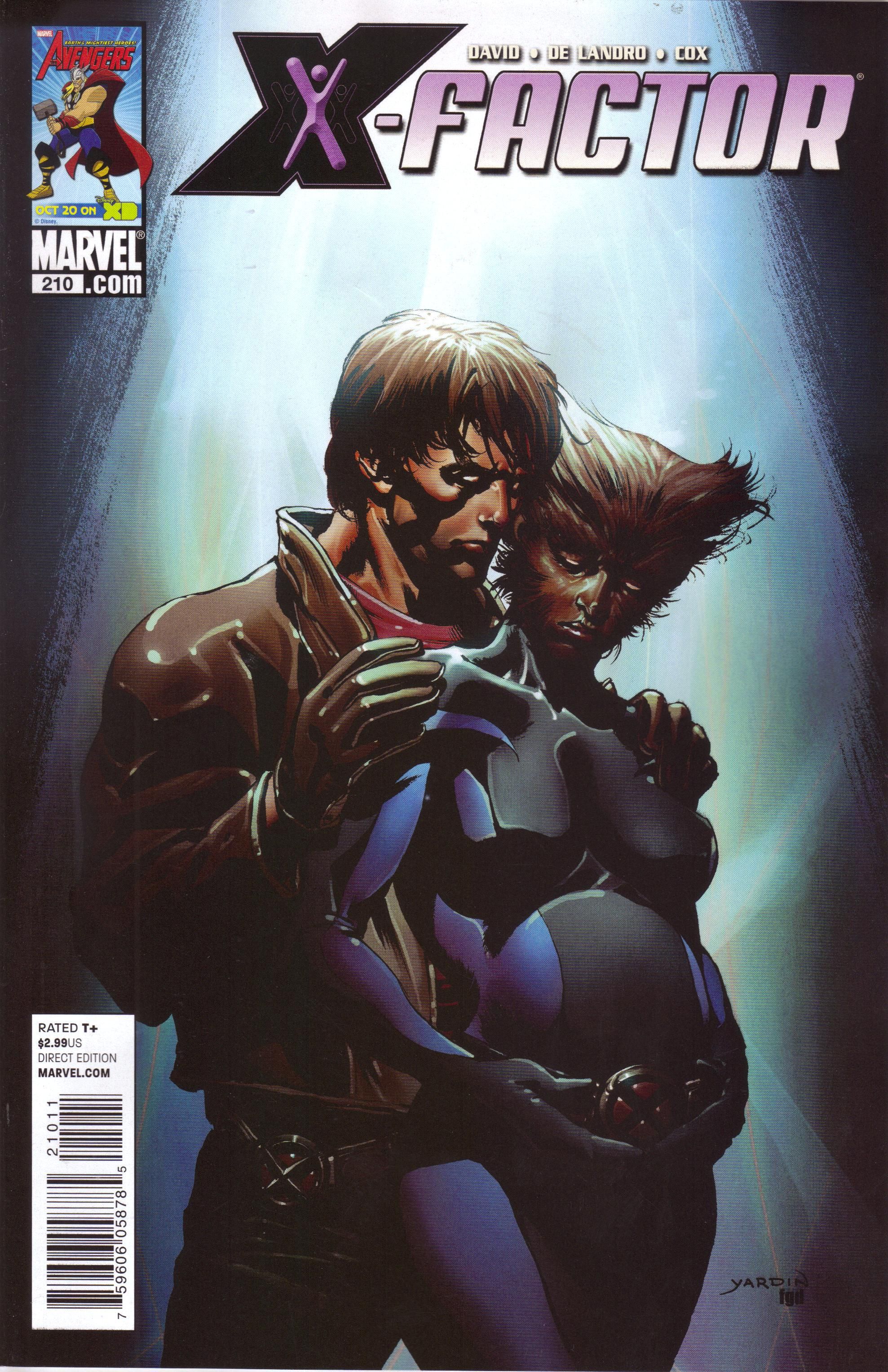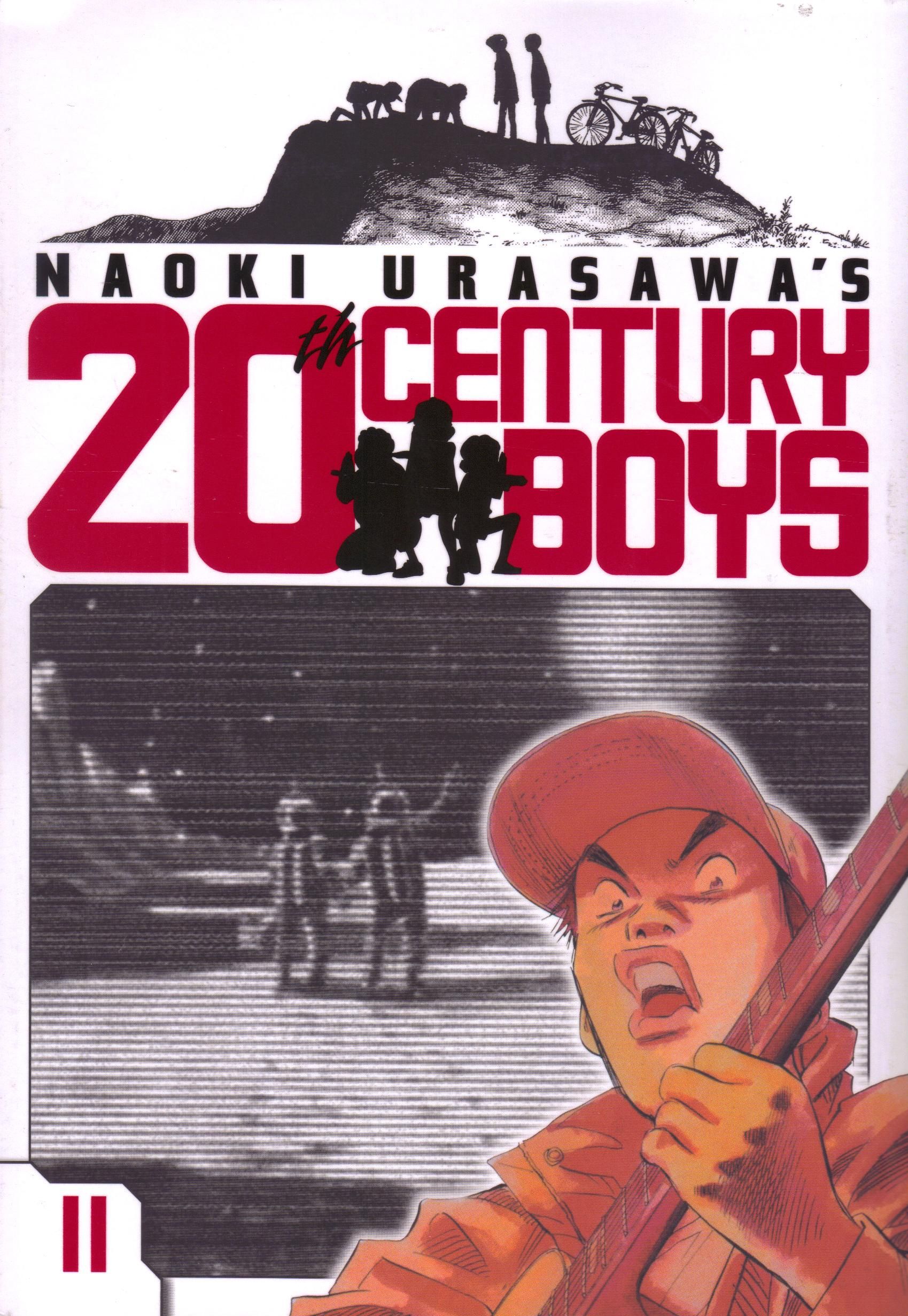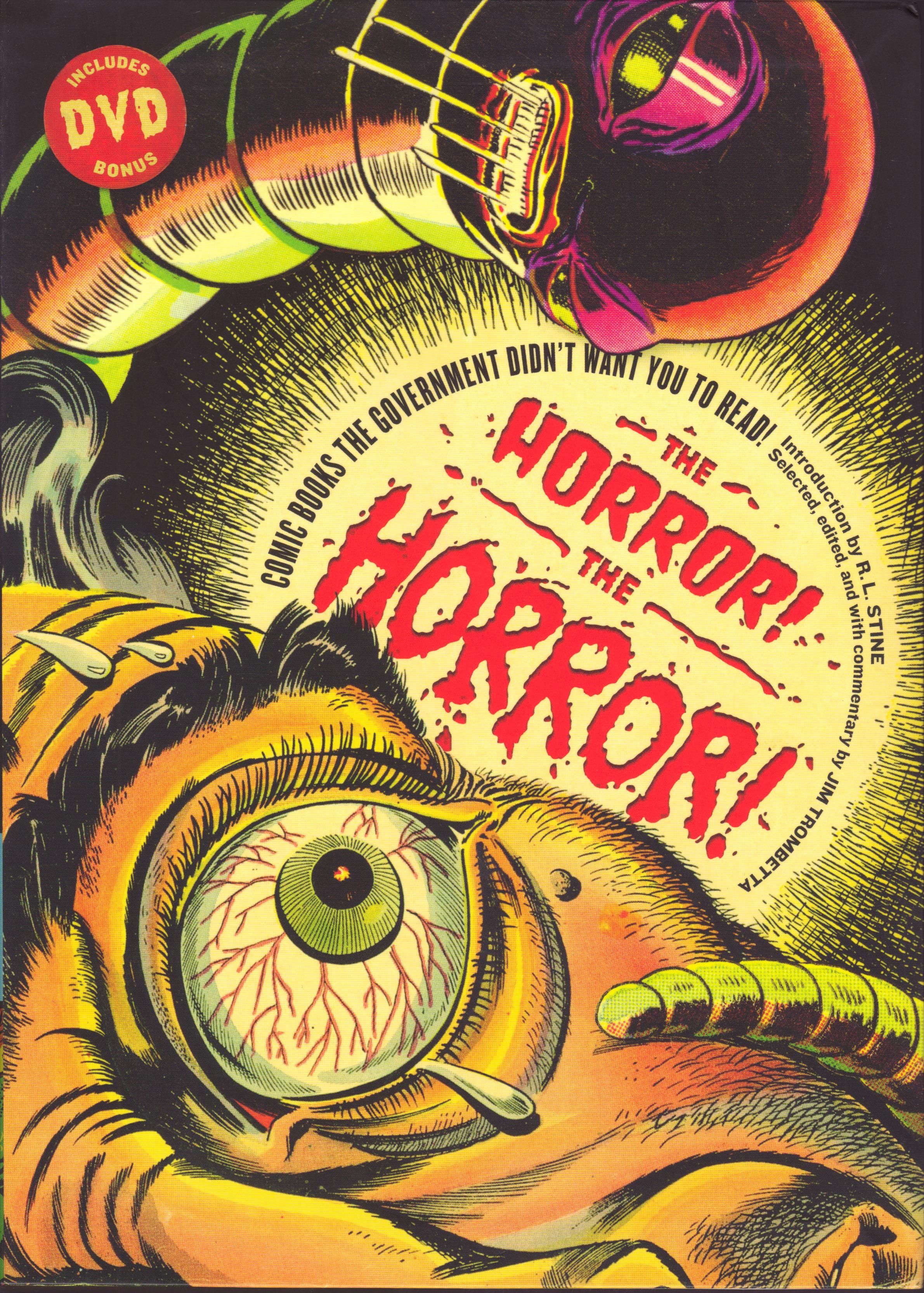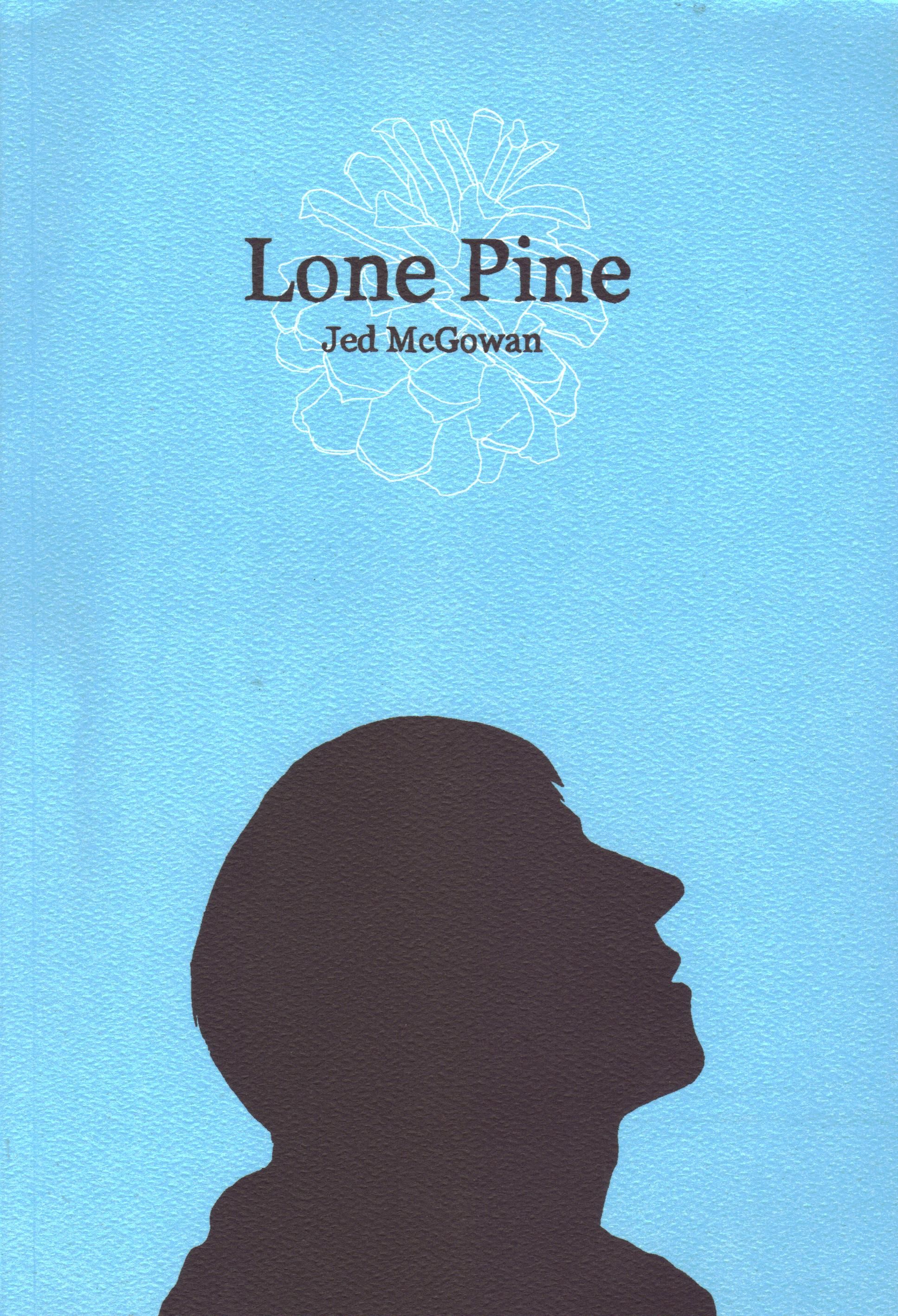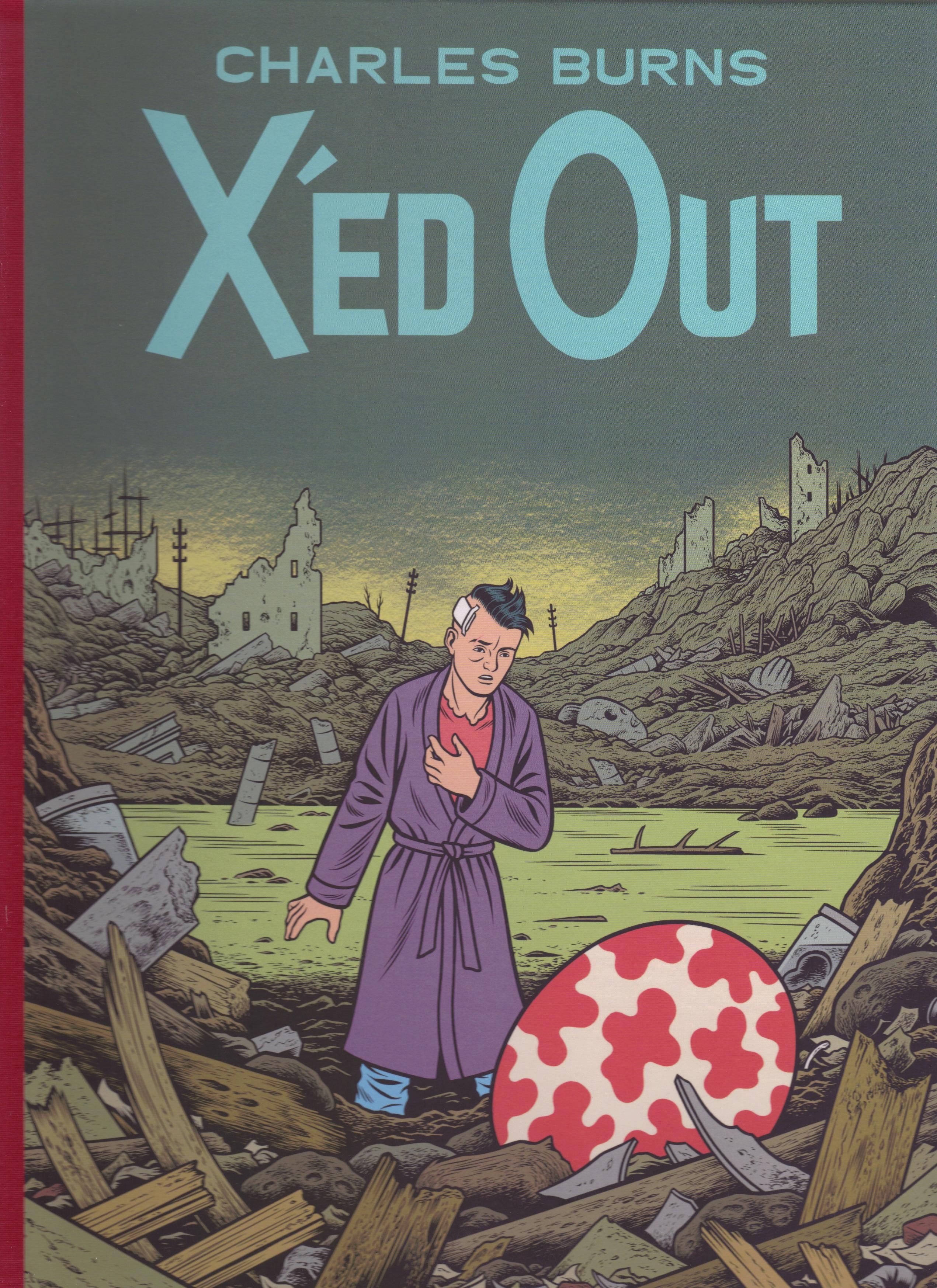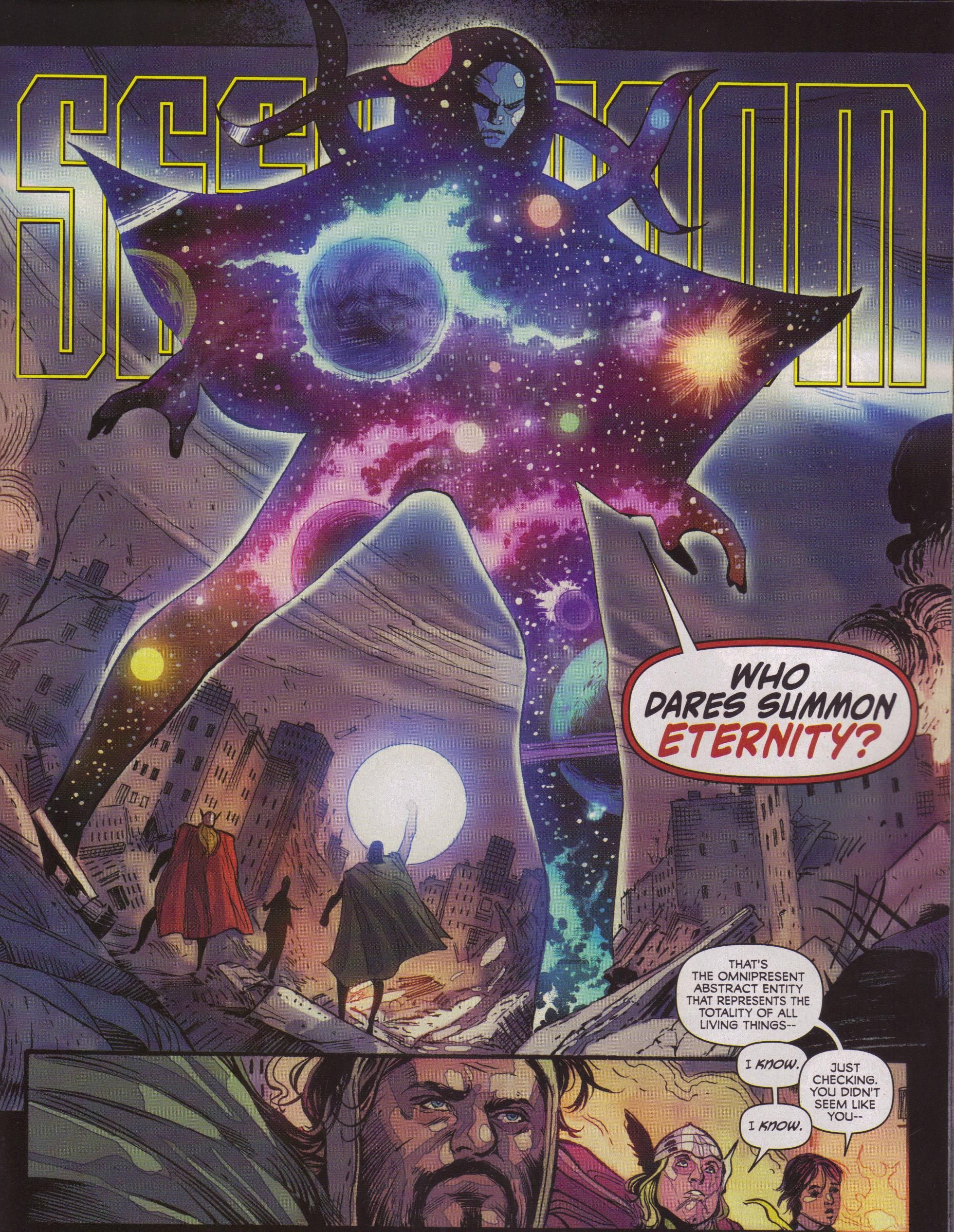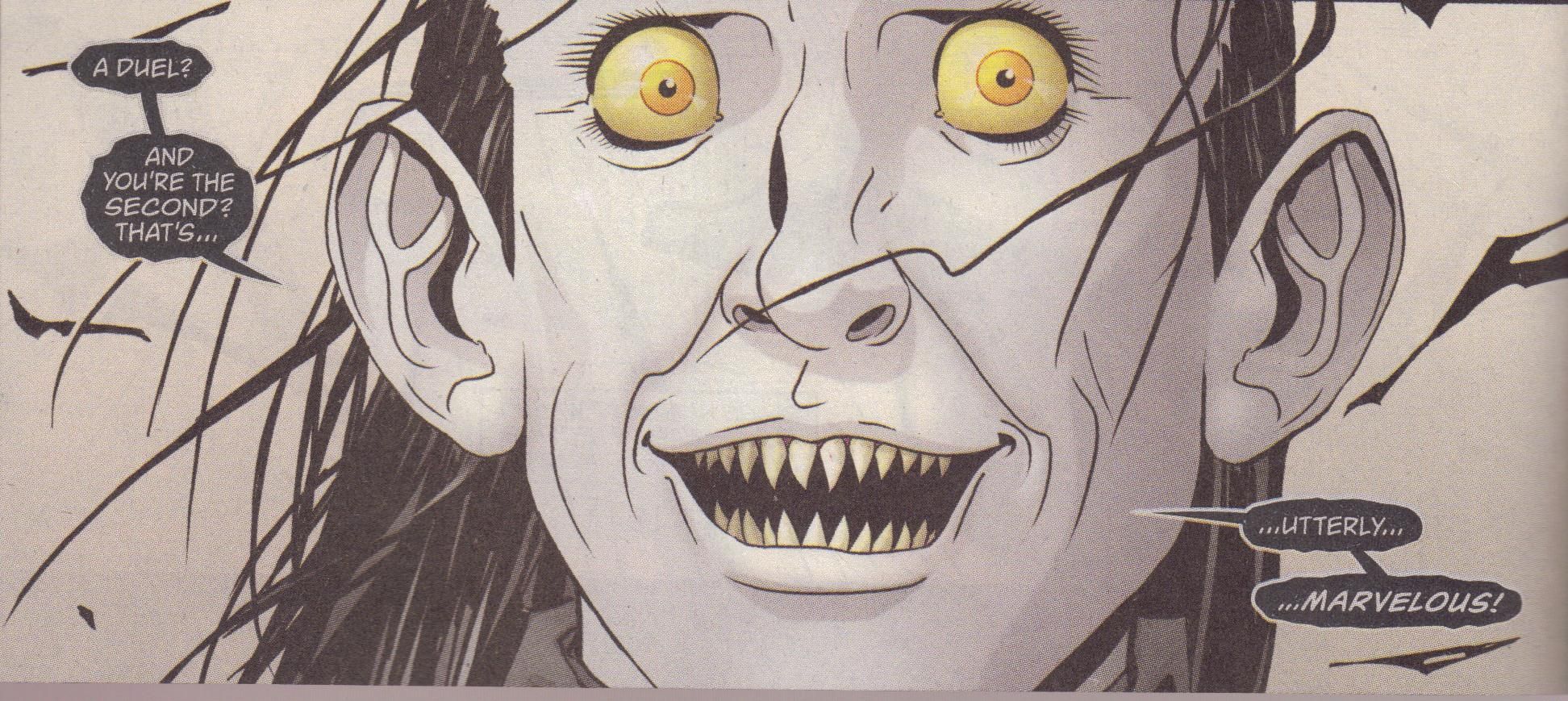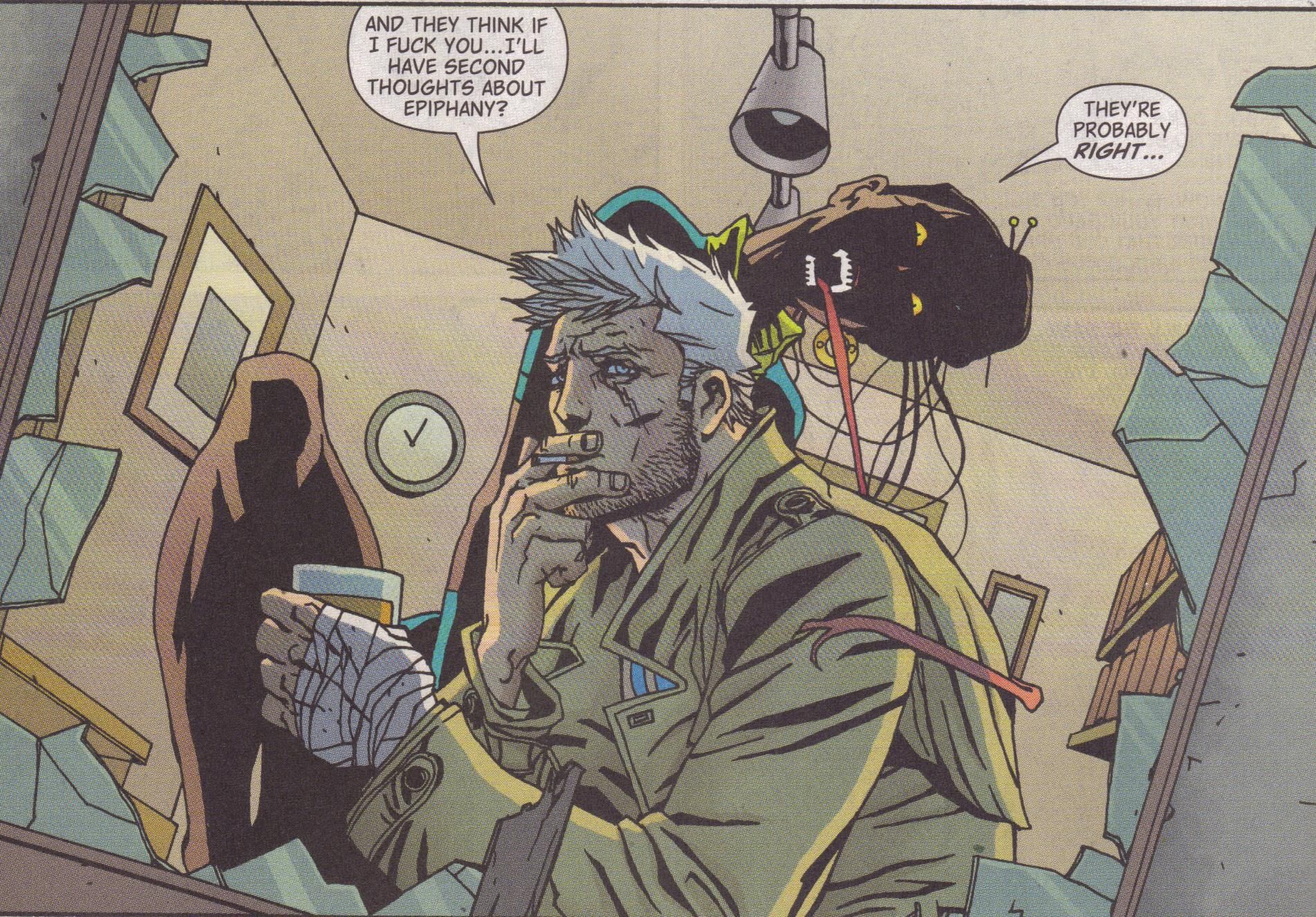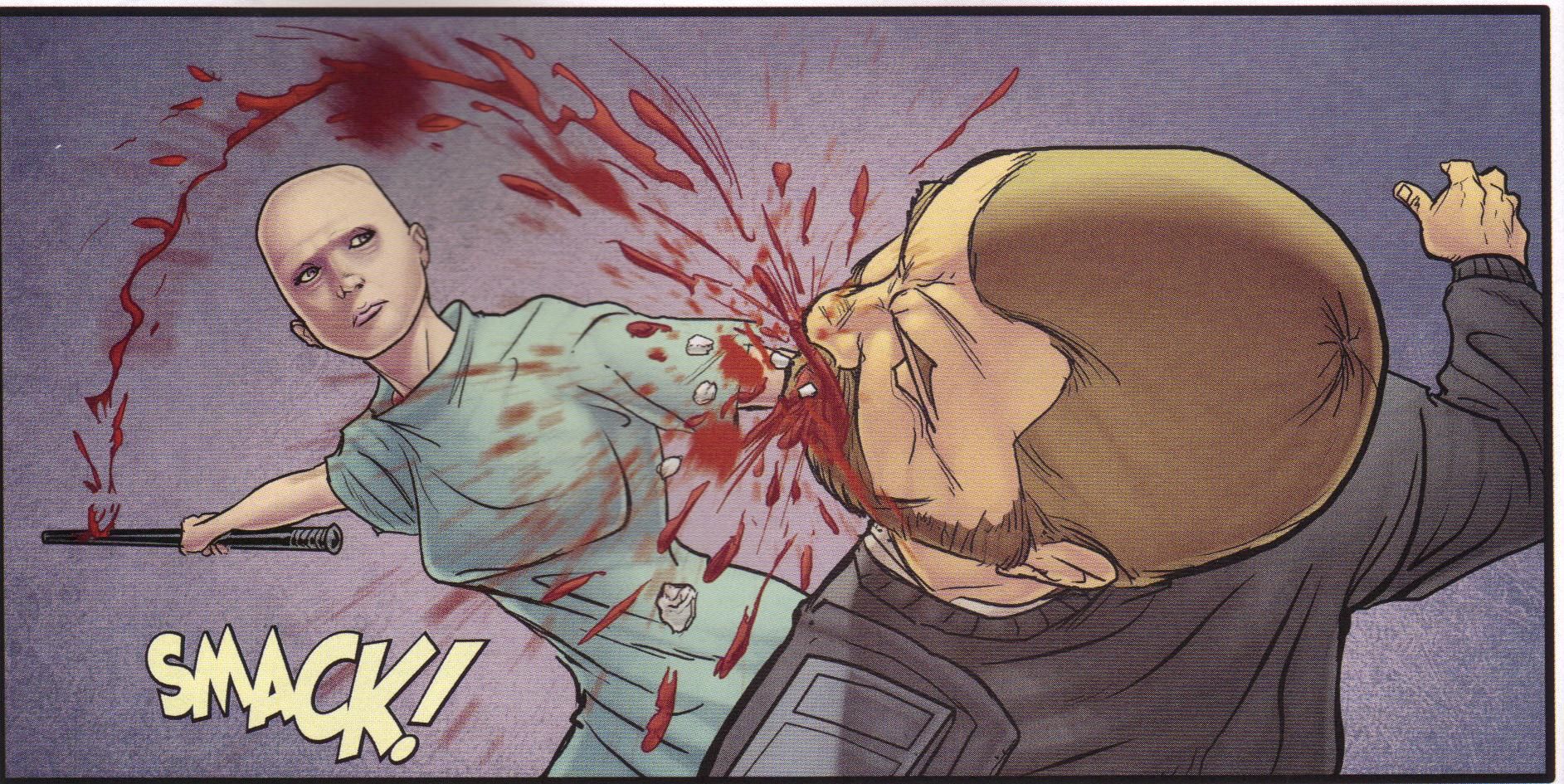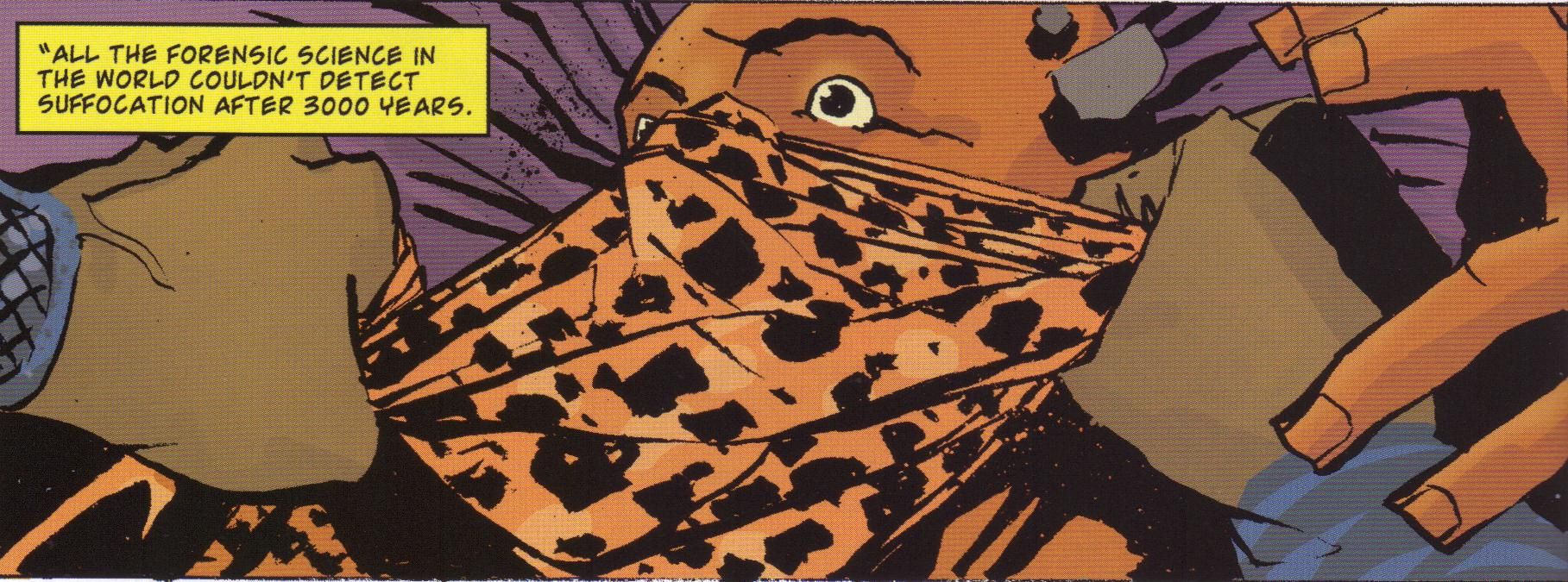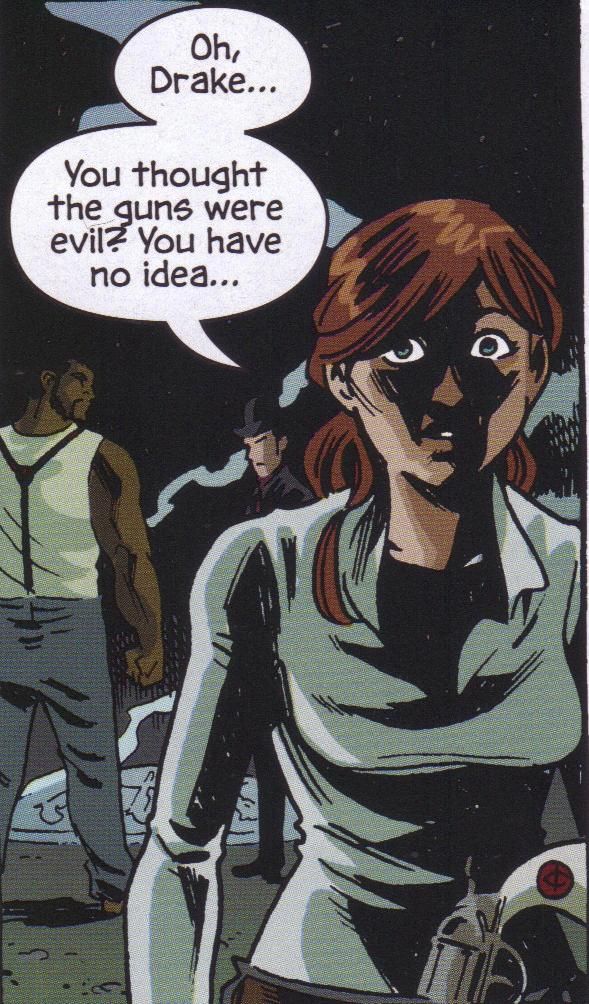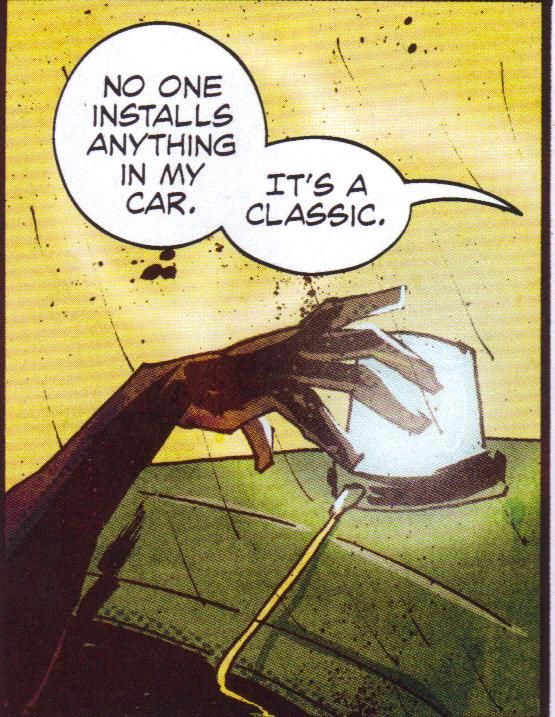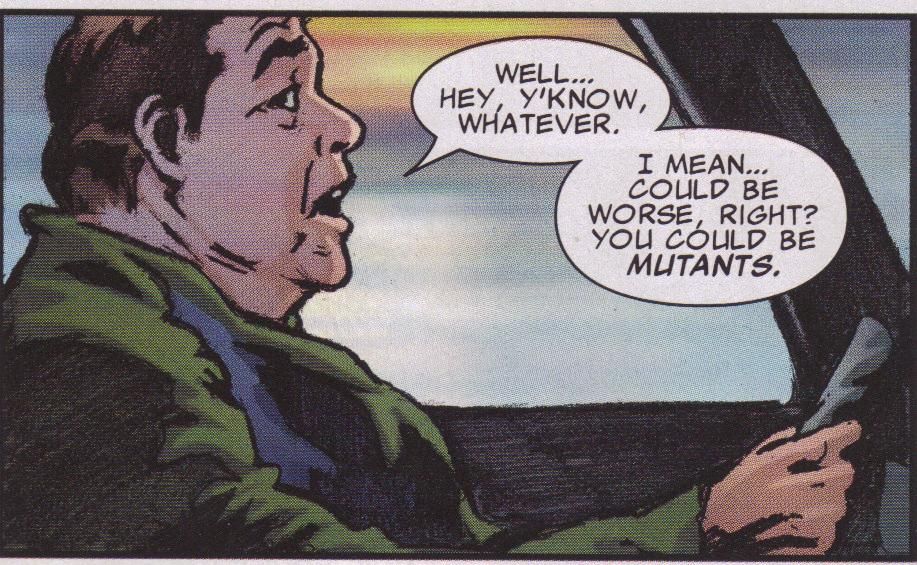What can be broken, should be broken. (Dimitri Pisarev, 1840-1868)
Batman and Robin #15 ("Batman and Robin Must Die! Part 3: The Knight, Death and the Devil") by Grant "Every comic I write from now on will have Batman coming out of the mist, and you'll love it!" Morrison (writer), Frazer Irving (artist), and Patrick Brosseau (letterer). $2.99, 22 pgs, FC, DC.
I suppose I ought to be keeping up with the cover story about Bruce Wayne and where he is, but I haven't. So can anyone explain to me why a member of the media asks Thomas Wayne if his return has "anything to do with [his] son's bizarre behavior"? What bizarre behavior? What have they been told about Bruce and his absence? I should remember this, but I don't. I apologize.
The other question I have: At the end of the issue, is that Dick attacking Dr. Hurt alongside Damian? I can buy him getting out of his bonds and taking out the henchmen in apparently 30 seconds (from the point where he tells Damian to stall to when he attacks, it can't be more than 45 seconds and probably closer to 30), because he's Batman (or a reasonable facsimile thereof) - and I'll even buy him taking the time to put his cowl back on. But a few pages earlier, Hurt shoots him in the head. Then he says that the pellet won't penetrate his skull, "but it has been expertly placed to fracture the skull and cause a hematoma." So it hasn't yet fractured the skull? Is that it? Hurt explains that in 12 hours, Dick will suffer permanent neurological damage, but it seems like the process has already begun and that Dick's skull is, in fact, fractured. Wouldn't that keep him down for the count for quite some time even if it didn't cause neurological damage? Dick seems awfully spry for someone who just got shot in the head. I know, it's comics. Shut up, Greg.
Irving does some very nice work in this issue, especially with the Quitelyan mini-panels surrounding the main panel when Damian tries to rescue Dick. Some people might think that Irving's art is too stiff, but what he lacks in fluidity he makes up for in style and design, and each page of this arc has been really nice to look at, because Irving does some nice things with details, perspective, and coloring that make the art absolutely stunning. As Dick and Damian's world goes insane around them, it's nice to have an artist whose work is a bit off-kilter along for the ride, because it makes Morrison's scripts more vertiginous than they might otherwise be. There's nothing wrong the story, to be sure, but it's nice that we have Irving drawing it to add a bit of extra oomph to it.
Cameron Stewart is back next issue. DC claims it's a 3 November ship date. WE SHALL SEE!!!!!!
One totally Airwolf panel:
Chaos War #2 (of 5) ("Return of the God Squad") by Greg Pak (writer), Fred van Lente (writer), Khoi Pham (penciler), Tom Palmer (inker), Sunny Gho (colorist), and Simon Bowland (letterer). $3.99, 23 pgs, FC, Marvel.
Van Lente and Pak use this issue to bring the new "God Squad" together, as Hercules asks for help from some entities who refuse to help fight the Chaos King (Eternity) and from some entities who might help (Galactus) and to show that the Chaos King is reanimating the dead to serve him. Someone somewhere brought up that it's similar to Blackest Night in that regard, which is certainly true, but it's not like reanimating dead people is all that novel a concept, so we'll just have to see where the writers go with it. We don't quite spin our wheels in this issue, but it still feels like it could be shorter - yes, the Pak/van Lente brand of humor is always fun and the sound effects are always fun and some of the information is important, but it still feels like there's a lot here we could assume. Coming from something like Batman and Robin (which I read after this, but reviewed first), it's interesting to contrast other comics where the writers aren't quite as confident about letting readers make their own connections. You may hate Morrison's style, but he does force the reader to make mental leaps that other writers don't, and it's interesting when you get something like this, where half of it could be excised without missing a beat, story-wise. Humor-wise, van Lente and Pak need the beats, so I can forgive the excess a bit, but that means that once we get past the humor (which isn't all that prevalent, as this series is a bit more "serious" than some of the Herc/Amadeus arcs of the past), it feels a tiny bit hollow. I can only imagine how vacuous the tie-in series will be.
But it's always fun to see Daimon Hellstrom. I wonder if Pak and van Lente will update us on the status of Jaime Cutter!
One totally Airwolf panel:
Fables #99 ("Dark City") by Bill Willingham (writer), Inaki Miranda (artist), Eva de la Cruz (colorist), and Todd Klein (letterer). $2.99, 22 pgs, FC, DC/Vertigo.
The guy at the comics shoppe and I were discussing Fables recently. He likes it as much as I do, and we were wondering what was going to happen in issue #100. From the events of this issue, it seems like there's going to be a duel between the Dark Man and Frau Totenkinder in her new, foxy guise.* That's all well and good, but doesn't it seem a bit anticlimactic? I mean, the Dark Man (who we discover is a "dullahan," meaning, according to the Internets, that he should be headless - could the Dark Man be from a certain Washington Irving story, and he has now recovered a head?) is supposed to be all scary and shit, but he hasn't really done much, has he? He's standing around Fabletown enslaving the feeble mundys, and all we keep hearing is how scary he is. In this issue, the cat spy tells Ozma that the Fables have left a trail to the Farm and that the Dark Man is going to find it soon, but he hasn't done it yet. Almost everything we know about the Dark Man is because all the other characters talk about how creepy he is and how powerful he is. At the end of this issue, Totenkinder even mentions that she doesn't think the duel will be all that difficult because the Dark Man is overconfident. So what exactly is going to happen in issue #100? Obviously, it's a big issue and I'm sure Willingham has some kind of plan to make it special. But I really hope Totenkinder doesn't defeat the Dark Man and that he becomes a bigger threat, because if she does beat him, he'll go down as kind of a lame villain, don't you think?
Anyway, I've never seen Miranda's art before, but he does a really nice job, especially with the urban scenes. His fantasy scenes (the winds teaching Snow and Bigby's kids; Totenkinder's meeting with the North Wind on the Farm) are a bit less effective (a bit too wispy, as if he's trying for whimsy but can't quite pull it off), but the scenes with the Dark Man and his mindless minions are much more effective. He's not as good as Buckingham, but he's a good fill-in artist.
We'll see what happens in issue #100. Either way, it's fairly impressive to make it this far. And, apparently, Willingham has absolutely no plans to finish this, ever. You'll pry Fables from his cold, dead, conservative fingers!
* I don't care as much as Kelly that Totenkinder went from old lady to hot young thang, because I'm a porcine male, but one thing that bugs me is that I don't remember Willingham giving us any reason for it. I'm trying to remember if, when she abdicated to Ozma or soon after, she gave any explanation for her "youthening." I would have thought Willingham was going to have her do some seducing or such and therefore it would have helped if she were more comely, but he hasn't (to his credit). She hasn't done anything that seems to require her to be young. So while I'm not terribly bent out of shape about it (Ms. Thompson, remember, hates attractive women - other than herself - with the white-hot hatred of a thousand suns, so it's not surprising she's raging about it), I do wonder why, exactly, Totenkinder isn't old anymore. Did I forget a reason?
One totally Airwolf panel:
Hellblazer #272 ("Bloody Carnations Part Two: Life on Venus and Mars") by Peter Milligan (writer), Simon Bisley (artist), Giuseppe Camuncoli (layouter), Stefano Landini (finisher), Brian Buccellato (colorist, Bisley's art), Trish Mulvihill (colorist, Camuncoli/Landini's art), and Sal Cipriano (letterer). $2.99, 22 pgs, FC, DC/Vertigo.
So late in this issue, when Nergal (that's Nergal, right?) talks the succubus whom he wants to seduce John so he'll forget about Epiphany (it's all very simple and believable, to paraphrase Woody Boyd), he says, "You can see why he gives us so much pleasure. All that arcane knowledge in the hands of a self-destructive fuck-up. It makes for wonderful viewing." And with that, Peter Milligan gets to the absolute heart of John Constantine and Hellblazer. Exeunt.
One totally Airwolf panel:
Morning Glories #3 by Nick Spencer (writer), Joe Eisma (artist), Alex Sollazzo (colorist), and Johnny Lowe (letterer). $3.50, 26 pgs, FC, Image/Shadowline.
As you well know, if I mention the delightful Ms. Kelly Thompson thrice in one post, I get a "I Hate Man Comics" badge to wear proudly to comic book conventions, so I'll mention her again (who knows if I'll mention her again - can you stand the suspense?!?!?). In her second post about ladies reading comics, I commented that perhaps she should let the readers know that comic book cover art often doesn't match the interior art. Several people pointed out that this knowledge would dilute the experiment, and I see their point. The reason I brought it up was because the cover art to Black Widow #6 didn't match the interior art and DeAnne was a bit disappointed. But it had come up in Part 1 as well, when Alexa expressed disappointment that Joe Eisma's interior art didn't match Rodin Esquejo's cover art on Morning Glories. Rebecca Hahn, who read Fables #98, was also put off by the disconnect between cover art and interior art. I didn't want to bring it up in the Fables review, but I will here: I think interior artists ought to do more covers, but I also understand why that doesn't occur as much as it used to. For people who have never read comics before, I think it's important to point out that maybe, just maybe, the cover artist's interior work would not be as good as the cover. It's certainly possible it would be, but perhaps some cover artists just aren't very good at sequential storytelling and interpreting a writer's script. Time is also a factor. Let's say Morning Glories, for instance, is being rapidly turned over. Joe Eisma has to draw 26 pages in a month (pencils and inks, mind you) and make sure it's coherent. Esquejo has to produce one image, with the only direction (presumably) being, "Show a sinister nurse about to inject a female student with something nasty." There's no sequential storytelling involved. That's not to say Esquejo couldn't crank out 26 excellent pages, but who knows? Time comes into the equation, too. Many artists become cover artists because it pays well, but also because they just can't do a monthly book on time (or even an annual book, for some artists!). When DC gave J. G. Jones plenty of lead time (presumably) to do Final Crisis, he couldn't finish it (how much this has to do with Morrison's scripts being late is still up for speculation). We can argue all we want that comics shouldn't be subjected to the strictures of monthly publishing, but until they're not any longer, there are going to be covers that don't match up with the interior art.
All right, that's enough of that rant. Go read Kelly's posts, because they're very neat in general. I suppose I should write a bit about this issue, which, like another book further down the list, bugged me a bit. Spencer introduces an idea in the beginning of the book that this academy - or something like it - is centuries old and has been imprisoning kids for that long. He ties it all in with what's currently going on in the school, and I guess there will be more of it in future issues. Now, there's nothing really wrong with this idea, but I guess I'm getting bored by the whole "centuries-old institution manipulating humanity for their own sinister ends" thing that is such a common trope in comics (and in fiction in general, but far more in comics, it seems). I certainly understand WHY secret societies and conspiracies are so tempting to comic book writers - visually, they allow artists to have some fun in other time periods, and they provide a nice, long overarching plot for the writer to play with - but I do get weary of them. As with anything, it's all in how Spencer (and other writers) work with it, so it's not a deal-breaker for the comic in general, but it is somewhat frustrating. Secret societies in comics are almost NEVER convincing, and I don't have a ton of hope that this one will be. We shall see, shan't we?
One totally Airwolf panel:
The Murder of King Tut #5 (of 5) by Alexander Irvine (writer), Christopher Mitten (artist), Ron Randall (artist), Dom Regan (colorist), and Neil Uyetake (letterer). $3.99, 22 pgs, FC, IDW.
Okay, some SPOILERS below. Tut dies, in case you're wondering. It's right there in the title!
So, yeah. I was really, really disappointed with the end of this mini-series, and by extension, the entire series. It started off quite well - dual stories, one about Tut and his world, the other about Howard Carter and his world - but started to falter in issue #4 and fell completely apart in this issue. First of all, as I wrote last time, Tut dies in issue #4. So this is a weird epilogue kind of issue in which James Patterson writes a book about his murder, figuring the whole thing out before the 22 pages are up. In a metafictional kind of way, that's not a bad way to go, but that's about as interesting as this issue gets. First of all, Howard Carter's story ends up going nowhere. Yes, in previous issues there was a bit about the struggles he had finding anything good in Egypt and how long it took before he discovered Tut's tomb, but ultimately, there's nothing really to recommend about his story, and it ends abruptly, with nothing terribly dramatic happening (yes, I know people's lives often are devoid of drama like we expect in fiction, but then why even write about Carter at all?). Meanwhile, "James Patterson" solves the murder of King Tut and writes a book about it, meaning we get to see a lot of Mitten's excellent art (I like Randall, who did the modern art, but I like Mitten more) because the book mostly takes place in ancient Egypt, but it also means we get Patterson narrating about events, which robs the book of much of its dramatic tension. It's like the end of a Hercule Poirot mystery, except Poirot usually surprises the reader more. Patterson's explanation of Tut's murder reads like a National Geographic article. Sure, it's informative and it has pretty pictures, but it lacks drama, and as this is a fictional story, I don't think it's too crazy to expect drama. Finally, recent evidence suggests that Tut wasn't murdered at all. So Patterson hasn't solved anything. This comic is based on a fairly recent book (it came out about a year ago), so I imagine Patterson knows all this. He can speculate about Tut's "murder" all he wants, but I do wish the comic had made the story more dramatic. This final issue is somewhat inert, and it almost invalidates all the interesting things that happened in the first 3½ issues. Too bad.
One totally Airwolf panel:
The Sixth Gun #5 by Cullen Bunn (writer) and Brian Hurtt (artist/letterer). $3.99, 24 pgs, FC, Oni Press.
As this has rapidly become one of my favorite comics, I really hope it's doing well enough that Bunn and Hurtt can continue doing it, and I hope Hurtt can keep up with the pace, even if they have to skip months in between story arcs (which is what Chew does to allow Rob Guillory some breathing room). Hurtt is so freakin' good and he's wearing so many hats on this comic (everything but writer) that I do hope Oni lets them do it for as long as they want. Buy The Sixth Gun, people! You won't be disappointed!
Of course, I have a complaint. This is the second book this week that ties in events in the present (and yes, I'm aware this book takes place in the Old West, but it's the "present" in the comic) with a long tradition, in this case the guns our heroes and villains are carrying. I find it a bit less egregious than the idea of a secret society in Morning Glories because, so far, Bunn hasn't introduced some sort of sinister cabal, just pointing out that the weapons are always with humanity in some form or another, which I can deal with, but from there it's only a short step to conspiracies, and I do hope Bunn doesn't go that way! We'll see, of course.
Anyway, in this issue Becky, Sinclair, and Billjohn make it to the Maw, a prison where the general put his worst enemies. After the war, a bunch of prisoners stayed because of the legend of General Hume's treasure, which is buried in a deep well in the Maw and locked in a vault that needs all six guns to open. Becky, however, realizes there's something far different than treasure, something much worse than the general ... but of course, we don't learn what that is. So the general shows up, setting the stage for the big battle that ends the first arc. Exciting!
Bunn and Hurtt do such a nice job slowly building the tension, even early in the book when Sinclair gets another gun thanks to a clever trap. This is a beautiful comic, and the fact that Bunn and Hurtt have long-term plans for it just makes me happy. You know you want to buy it, people! Don't be shy!
One totally Airwolf panel:
Sweets #3 by Kody Chamberlain (writer/artist). $2.99, 22 pgs, FC, Image.
This is very weird. Sweets #2 came out two months ago, but I don't recall very much about it. It came out during the week I was back in Pennsylvania and so I didn't review it, my friend Dave did, but I did read it, so I ought to remember more about it. I remember the flashback with some clarity, but the drug trial stuff is fuzzy - I know it's in the first two issues, but I can't remember much about it. It's very possible I may be dim. This is not the first time I've been confronted with that fact.
Chamberlain seems to know what he's doing with regard to the story, however, so I'll just follow along with him. He's revealing things about the case and Curt's past in a nice, slow manner, and it feels pretty organic, which is always good. I was a tad disappointed with some of the art - in the outdoor scenes, there's a distinct lack of backgrounds, which makes it feel like everyone is in the middle of the desert rather than New Orleans. I wish Chamberlain had simply drawn in some vague building shapes, because that's all it would need. But he does a nice job with the car chase that turns into a foot chase into a cemetery, and there's a nice sense of foreboding about the coming storm, which is getting closer and closer (it's raining throughout this issue).
I'm certainly enjoying Sweets and look forward to the final two issues, but I'm a bit bummed that my memory is failing me. Maybe when I re-read the issues I'll slap my forehead and say, out loud, "Well, shit," but until then, I'll live in a foggy haze of foolishness. What year is it, anyway?
One totally Airwolf panel:
Turf #3 (of 5) ("Bad Fellas!") by Jonathan Ross (writer), Tommy Lee Edwards (artist), and John Workman (letterer). $2.99, 26 pgs, FC, Image.
Jonathan Ross is married to Jane Goldman, whom he wed when she was 18. And they're still together, so that's cool. Goldman was the screenwriter of Kick-Ass. Should we hold that against her? I dunno, I still haven't seen it.
In the long months since Turf #2 (almost three of them), I've read a few reviewers that absolutely loathe the series, especially the writing. Because I'm easily suggestible (just like Homer Simpson), I find myself agreeing with them, if not to the extent that they do (in other words, I still like the series and will continue to buy it). However, I really wonder why Ross is overwriting this sucker so much. It's gotten better since the unnecessarily verbose first issue, but it still lingers, and it's really throwing off what should be a better series. While Ross has eased back on the omniscient narration of the first issue, there's still too many words in this book. (I know that's like the emperor criticizing Mozart for putting too many notes in his music, but Ross ain't Mozart, I'll tell you that much.) Ross, like many people who come to comics from a different medium, is having difficulty realizing that a good artist is very capable of telling the story, and you just don't need so much verbiage. It's too bad, because the overall plot is still pretty cool - the reporter, Susie, rescues Gregori when his clan rebels against him, while Eddie Falco comes to an understanding with Squeed, the alien, and everything moves forward - but Ross is trying to stifle it with words. As I pointed out, he's getting better, so maybe by issue #5 he'll have learned more about writing a comic.
Edwards, of course, does amazing work, which is why it's frustrating to see word balloons and narrative boxes splashed over the art so much. He has a couple of really nice double-page spreads showing the secret origins of Eddie, Squeed, and the "vampires" (who aren't really vampires, according to Gregori, although they really are), and there's one page where Pete, the crooked cop, flashes back to his childhood that's done in the style of early 20th-century comic strip art, and it's really stunning (plus, it takes the silliness of the strips and adds several sinister touches, which makes it more disturbing). Ross is getting better at letting Edwards show his stuff, and it helps the series very much. A lot of what Ross narrated earlier in the series wasn't necessary because as Eddie and Susie move through this world, we find out a great deal, so Ross keeping us in the dark briefly earlier wouldn't have mattered too much. Oh well.
I expect the next issue will come out in January or February. We shall see! I'll try not to be swayed by other, smarter reviewers. I'll just be sitting here, dragging my knuckles and trying to crack a nut on my forehead. It's fun!
One totally Airwolf panel:
X-Factor #210 by Peter David (writer), Valentine de Landro (artist), Jeromy Cox (colorist), and Cory Petit (letterer). $2.99, 22 pgs, FC, Marvel.
As you ought to know, it is my contention that the all-encompassing lesson of popular culture is Never Trust The Woman, and it's unfortunate that far too often, I'm proven correct. So when a woman tormented by nightmares of her tour of duty in Iraq shows up at X-Factor headquarters and begs Monet to make those nightmares go away, I was thinking to myself, "Monet - don't trust the woman! There's probably a reason why, in her dream, children are pointing their fingers at her, gun-style! Why don't you ask yourself why they would do that?!?!?" Of course, Monet doesn't, and it turns out that, in the end, we ... (everyone with me!) ... SHOULDN'T TRUST THE WOMAN! Of course she's a bad guy! Sigh. She's a pretty cool bad guy, though, so that's okay.
I'm always amused by Rahne's medieval outlook on life, but do people who are not idiots (and I'm pretty sure Rahne isn't an idiot) still believe that they can turn people gay? She asks Rictor if she did that to him, and of course he laughs at her (not in a mean way, just in an incredulous way). I just wonder if people (who are not idiots) still think that. I'm not saying they don't, because I don't know many people in the first place, and the ones I do know tend not to think that way, so I'm just wondering. Does anyone out there in Internet land know someone who believes you can turn someone gay? Sound off!
And how does the doctor instinctively know that Rictor isn't the father? She's suspicious just by looking at him. That seems weird. Even if she senses that he's gay, the last time I checked, gay men could certainly impregnate a woman. These are the things that keep me up at night.
Finally, Valentine de Landro is back on art, which isn't great (especially considering how good the art has been for the past three issues), but he's inking himself, which makes his art sturdier and, frankly, better. Noelle's dream sequence in particular is very well done. De Landro obviously can't do a monthly book, so why not let him ink himself all the time, if it's going to be so much stronger than when Pat Davidson inks him? Beats me. What do I know, I'm just a guy who reads 50 comics a month.
So it's a solid issue of X-Factor. A bit more smug than usual (the cab driver and the doctor are both somewhat smug), but that's kind of what you get when you buy a Peter David comic - it rises up every once in a while. I don't care too much, because he's doing such a nice job with this comic. It's just moving right along.
One totally Airwolf panel:
20th Century Boys volume 11 by Naoki Urasawa (writer/artist). $12.99, 228 pgs, BW, Viz Signature.
I'm three volumes behind on this, and I really should get reading it, because it's so damned good. So don't spoil it, pretty please!!!!
The Horror! The Horror! Comic Books the Government Didn't Want You to Read! by Jim Trombetta (ed./commentary). $29.95, 306 pgs, Abrams ComicArts.
This isn't really a comic, as it's a book about the horror comics of the 1950s, but it includes a lot of covers and some of the stories, so I guess it counts. It looks really keen, so I hope it is!
Lone Pine by Jed McGowan (writer/artist). $15, 165 pgs, FC, AdHouse Books.
I can't really tell much about this just by flipping through this, but it's extremely minimalistic, both in the art and the very few words. I'm curious if it still works.
X'ed Out by Charles Burns (writer/artist). $19.95, 52 pgs, FC, Pantheon Books.
The good: It's very neat looking, and with Burns, you can always count on plenty of weirdness. It's also a nice large hardcover, so the packaging is pretty keen. The bad: It's only volume 1, which goes into bad point #2 - it's only 52 pages for 20 dollars, and it's only volume 1. That's pretty steep.
In news from around the world, Arizona Crazy Person Russell Pearce has decided that Senate Bill 1070, his baby, isn't keeping his name in the headlines enough, so now he's going after the 14th Amendment. You know the one - it means people who are born here are automatically citizens. Pearce wants the Supreme Court to revisit an 1898 decision that interpreted it this way rather than, according to him, the way it was intended, which is making sure ex-slave owners couldn't deny southern blacks citizenship. The funniest (or, perhaps, saddest) thing about that news story is that Pearce is claiming that the "new" interpretation robs blacks of their legacy. Russell Pearce - civil rights activist! Pearce claims that because illegal immigrants are not subject to U. S. jurisdiction (because they can't be drafted or serve on a jury), the 14th Amendment doesn't apply to them. If that sounds dicey to you (illegal immigrants can be jailed, which sounds like the U. S. has jurisdiction over them, and the citizen-babies of illegal immigrants can be drafted and can serve on a jury, because they're, you know, citizens), you're not alone. But Pearce (who's a state senator and will soon be the power behind the throne once our bumbling governor gets elected - she replaced Janet Napolitano when she went to Washington - only because she signed SB 1070, meaning Pearce will have her in his pocket) is aiming for ... something, and it sure doesn't include those south-of-the-border types! Yay, Arizona!
In happier news, my daughter has been watching television. Yesterday she watched the new Avengers show on Disney Channel. Her review is thus: It was good, but kind of boring (yeah, I don't know what that means). She liked the Wasp (the little woman with wings), Iron Man, and the guy with the hammer (Thor, and it took me a while to figure this out, because she kept talking about the metal guy, and I thought she meant Iron Man, even though she knows who Iron Man is). She didn't like the Hulk. She also didn't like the bad guy (Graviton, I think - I wasn't watching it). She's currently watching the newest episode of Scooby-Doo! Mystery Incorporated, "The Shrieking Madness." It aired a couple of days ago. It guest-stars Harlan Ellison, because it's freakin' awesome. Early in the episode, he's signing copies of his book, which is called My Fiction is Better. And he's really grumpy, too. He yells at Shaggy for using "like" all the time and tells Velma that "jinkies" isn't an actual word. Plus, some Che Guevara lookalike is protesting everything (including "old person smell"). It is, of course, the greatest Scooby-Doo episode ever. The new episodes of Scooby-Doo are kind of weird, because of the sexual dynamics. Daphne obviously digs Fred, but Fred is too obsessed with traps to notice (it's a very humorous running gag). Meanwhile, Velma keeps getting vexed that Shaggy is choosing Scooby over her. Yes, Shaggy is choosing to hang out with a Great Dane and eat ridiculous amounts of food than tap the nerdy hawtness of Velma. It's a bit of a bizarre show, I tell you that much. Although I'm not sure why the five of them keep splitting up and then getting back together as a mystery-solving group. Make up your minds, people!
Moving on, here are The Ten Most Recent Songs Played On My iPod (Which Is Always On Shuffle):
1. "Crazy Train" - Ozzy Osbourne (1980) "One person conditioned to rule and control, the media sells it and you live the role"
2. "Inside Information" - Foreigner (1987) "One man on the beat, wants everything that he's not allowed"
3. "Idiot Stare" - Jesus Jones (1993) "Pushed to the center, took no advice, waited in vain"
4. "The Guns of Brixton" - The Clash (1979) "When they kick out your front door, how you gonna come?"1
5. "Hasta Mañana" - ABBA (1974) "Where is the spring and the summer that once was yours and mine?"
6. "The Colorful Ones" - Liquid Jesus (1991) "I watch the life that I once cherished just wash away"
7. "Now or Never Land" - Midnight Oil (1993) "Suitcase full of good ideas, history that's filled with tears"
8. "Here I Go Again" - Whitesnake (1987) "Hanging on the promises in the songs of yesterday"2
9. "The Roof is Leaking" - Phil Collins (1981) "It's been months now since we heard from our Mary, I wonder if she ever made the coast"3
10. "Why Should I Cry for You?" - Sting (1991) "Dark angels follow me over a godless sea"
1 Because I haven't stirred the motherfucking pot enough today, London Calling is wildly overrated, isn't it? I mean, I've never been a huge fan of The Clash's punk/raggae thing, but I had hoped that this album would change my mind. But it has a few really good songs (the title track, this one, a few others) and lots and lots of filler. The Ramones blow them out of the water any day of the week and twice on Sundays ... and I don't even love the Ramones all that much!
2 This video might be the only time I've ever been grossed out by two people kissing. I mean, some kissing in movies and television looks weird, but David Coverdale and Tawny Kitaen almost swallowing each other's faces is really icky. I was 16 when I first saw this video, so it wasn't like I thought girls were icky. But those kisses ... brrrr.
3 You can say what you like about Phil Collins' solo career, and I'll mostly agree with you if you say it sucks, but this song is really, really good.
Last week no one got the totally random lyrics, although commenter jjc looked it up but didn't identify it. The lyrics were from Everclear's "One Hit Wonder," which is a notable song because the video does indeed feature Christina Hendricks of Mad Men fame (watch it here!). So there you go. How about some new totally random lyrics?
"Heaven help me for the way I am
Save me from these evil deeds before I get them done
I know tomorrow brings the consequence at hand
But I keep living this day like the next will never come
Oh help me but don't tell me to deny it
I've got to cleanse myself of all these lies 'til I'm good enough for him
I've got a lot to lose and I'm betting high so I'm begging you
Before it ends just tell me where to begin"
Have I pissed enough people off today? Please let me know!

